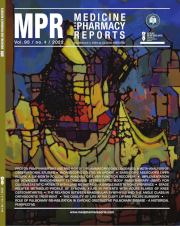Radicular dentinal microcracks during biomechanical root canal preparation using four minimally invasive endodontic files
DOI:
https://doi.org/10.15386/mpr-2455Keywords:
mandibular molar, microcracks, mesial root, nickel-titaniumAbstract
Aim. The aim of the study was to compare the dentinal microcrack formation on human mandibular molars using 4 different minimally invasive file systems at 3, 6 and 9 mm from apex using a stereomicroscope.
Method. 125 mesial roots of mandibular molars were randomly divided into 5 groups and instrumented (n=25). Group 1: Control Group (CG), Group 2: Self Adjusting File (SAF), Group 3: XP-Endoshaper (XP), Group 4: TRUShape (TS), Group 5: V Taper 2H (VT). After instrumentation was completed, the roots were sectioned at 3 mm, 6 mm, and 9 mm from apex using a slow-speed circular saw. Digital images were captured using a 24x stereomicroscope by using a digital camera. Two operators independently checked each specimen for the presence of dentinal defects. Statistical comparison between the file systems was done using Chi-square (p<0.05).
Result. There was no statistically significant difference in the frequency of microcracks between the groups of file systems (X2=4.509, p>0.05). VT file system exhibited higher microcracks (25%) but was not statistically significantly higher than XP (12%), TRUShape (12%), and SAF (4%) endodontic file systems.
Conclusion. Within the limitations of this study, it can be concluded that all the file systems used in our research are minimally invasive files and produced few dentinal microcracks. VT files produced maximum while SAF produced the least number of micro-cracks.
Downloads
Published
How to Cite
Issue
Section
License
The authors are required to transfer the copyright of the published paper to the journal. This is done by agreeing to sign the Copyright Assignment Form. Whenever the case, authors are also required to send permissions to reproduce material (such as illustrations) from the copyright holder.

The papers published in the journal are licensed under a Creative Commons Attribution-NonCommercial-NoDerivatives 4.0 International License.

